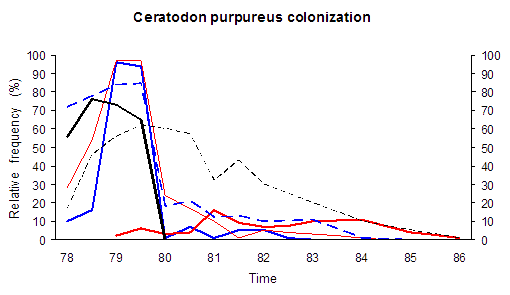Case StudiesCeratodon purpureusA pioneering species that colonizes burnt ground typically shows a relatively rapid occupation of the bare, recently burnt area followed by a decline in the area they occupy. By their nature pioneering species are capable of quickly exploiting a devastated area but are often unable to compete against other species. Therefore, after their initial success, pioneer species often lose area as other species, initially slower to establish, take over. The rates at which pioneer species gain and lose area vary. It's not surprising to hear that there is variation between species. However, even within a species there may be variation, the rates of both colonization and the later loss of area being influenced by local conditions. The following graph illustrates this. It shows the behaviour of the moss Ceratodon purpureus after severe fires in the northern summer of 1976 in heathland areas in Brittany, France.
The horizontal axis shows time, in years from 1978 to 1986. Each two-digit year marks July of that year. The vertical axis indicates the relative frequency of Ceratodon purpureus. The six different lines in this plot show the behaviour of Ceratodon purpureus in six different areas within the burnt heathland, representing six different habitats within the heatland. You'll notice that the thick red line starts in 1979. This reflects the absence of the relevant pre-1979 information from the reference which is the source of the information given in this graph, You can see that in a couple of sites Ceratodon purpureus coverage reached almost 100% of the areas concerned, while in others the maximum coverage fell short of 100% to varying degrees. You can also see that the area covered by Ceratodon purpureus did drop to virtually zero in all six sites, but there were marked differences in the rates of decline in coverage between the sites, Reference:
|
![An Australian Government Initiative [logo]](/images/austgovt_brown_90px.gif)


